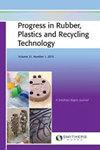遗传算法和粒子群优化的混合方法对减少注塑成型中焊缝缺陷的影响
IF 1.6
4区 材料科学
Q4 MATERIALS SCIENCE, COMPOSITES
Progress in Rubber Plastics and Recycling Technology
Pub Date : 2024-08-06
DOI:10.1177/14777606241270516
引用次数: 0
摘要
焊缝是注塑成型部件中的一种严重缺陷,会影响其外观和机械性能。控制注塑条件对减少这些焊缝至关重要。本研究采用一种新方法来确定聚丙烯注塑成型(PIM)条件,旨在减少聚丙烯部件中的焊缝。本研究考虑的注塑成型条件包括熔体温度、注塑压力、保压压力、保压时间和冷却时间。实验设置采用了正交阵列田口 L27 设计,用不同的工艺条件组合生产了 27 个聚丙烯部件。所有试验均使用最佳显微镜测量零件表面产生的焊缝宽度。使用响应面图和等高线图进行参数分析,以估计产生最小焊缝的工艺条件。采用方差分析和回归分析来解释实验数据,由此得出的回归方程用于预测一组 PIM 工艺条件下的焊接线。最后,使用 MATLAB 编程实现了遗传算法(GA)和粒子群优化(PSO)这两种高效的优化算法,以估算出最小焊缝线的最佳工艺条件。GA 和 PSO 预测的焊缝宽度分别为 6.12302 μm 和 6.123 μm,结果提高了 18.51%。这些结果表明,本研究提出的新方法可以有效、可靠地应用于解决行业中的塑料产品缺陷。本文章由计算机程序翻译,如有差异,请以英文原文为准。
The hybrid approach of genetic algorithm and particle swarm optimization on reduced weld line defect in plastic injection molding
Weld lines are a serious defect observed in plastic injection molded parts, impacting both their cosmetic appearance and mechanical properties. Controlling the conditions of plastic injection is crucial to mitigate these weld lines. This study introduces a novel approach to identify polypropylene injection molding (PIM) conditions aimed at reducing weld lines in polypropylene parts. The PIM conditions considered in this study include melt temperature, injection pressure, packing pressure, packing time, and cooling time. An orthogonal array Taguchi L27 design was employed for the experimental setup, producing 27 polypropylene parts with varying combinations of process conditions. The width of weld lines generated on the parts’ surfaces was measured using an optimum microscope for all trials. Parametric analysis was conducted using response surface plots and contour plots to estimate the process conditions yielding minimum weld lines. Analysis of variance and regression analysis were employed to interpret the experimental data, with the resulting regression equation used to predict weld lines for a set of PIM process conditions. Finally, two efficient optimization algorithms, genetic algorithm (GA), and particle swarm optimization (PSO), were implemented using MATLAB programming to estimate the optimum process conditions for minimizing weld lines. The GA and PSO predicted weld line widths of 6.12302 μm and 6.123 μm, respectively, representing an 18.51% improvement in results. These findings demonstrate that the novel approach presented in this study can be effectively and reliably applied to address plastic product defects in the industry.
求助全文
通过发布文献求助,成功后即可免费获取论文全文。
去求助
来源期刊

Progress in Rubber Plastics and Recycling Technology
MATERIALS SCIENCE, COMPOSITES-POLYMER SCIENCE
CiteScore
4.40
自引率
7.70%
发文量
18
审稿时长
>12 weeks
期刊介绍:
The journal aims to bridge the gap between research and development and the practical and commercial applications of polymers in a wide range of uses. Current developments and likely future trends are reviewed across key areas of the polymer industry, together with existing and potential opportunities for the innovative use of plastic and rubber products.
 求助内容:
求助内容: 应助结果提醒方式:
应助结果提醒方式:


